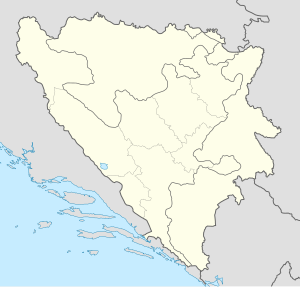
Back معركة كوبريس (1992) Arabic Bitka za Kupres 1992. BS Bitka za Kupres 1992. Croatian Битва за Купрес (1992) Russian Bitka za Kupres (1992) Serbo-Croatian Операција Купрес Serbian
| Battle of Kupres | |||||||||
|---|---|---|---|---|---|---|---|---|---|
| Part of the Bosnian War | |||||||||
Kupres and nearby towns on the map of Bosnia and Herzegovina | |||||||||
| |||||||||
| Belligerents | |||||||||
|
|
| ||||||||
| Commanders and leaders | |||||||||
|
|
| ||||||||
| Units involved | |||||||||
|
| ||||||||
| Strength | |||||||||
| 20,000 | 6,000 | ||||||||
| Casualties and losses | |||||||||
|
85 killed 154 captured |
160–177 killed 23 captured | ||||||||
| 38 civilians killed | |||||||||
The Battle of Kupres (Serbo-Croatian: Bitka za Kupres / Битка за Купрес) was a battle of the Bosnian War, fought between the Bosnian Croat Territorial Defence Force (Teritorijalna obrana – TO) supported by the Croatian Army (Hrvatska vojska – HV) troops on one side and the Yugoslav People's Army (Jugoslovenska narodna armija – JNA), augmented by the Bosnian Serb TO on the other at the Kupres Plateau, on 3–11 April 1992. During the fighting on 8 April, the Bosnian Croat TO was reorganised as the Croatian Defence Council (Hrvatsko vijeće obrane – HVO). The objective of the battle was to control the strategic Kupres Plateau, a major supply route.
The opposing sides began bringing in reinforcements to the Kupres Plateau on 5 March to strengthen positions held around individual settlements populated by different ethnic groups, communications between those positions, and roads leading away from the plateau to the north and south. Different parts of the town of Kupres were controlled by the opposing forces, while the adjacent territory surrounding the town was controlled by the Bosnian Croat TO. In turn, that territory was surrounded by Bosnian Serb TO-held territory. By the end of the month, the bulk of the civilians living in the area were evacuated. On 2 April, negotiations to defuse the situation failed while the reinforcements continued to arrive. The battle commenced the next day. In Kupres itself, the Bosnian Croat TO achieved minor territorial gains on 4–5 April, before the JNA managed to advance to the outskirts of the town the next day. The JNA entered Kupres in the afternoon of 7 April and in the next few days, it successfully drove the Croatian forces from the plateau. The breakthrough came about after the infantry originally deployed to the battle was reinforced by an armoured battalion deployed from Knin.
Croatian forces were hampered by an inadequate command structure, poor coordination and lack heavy weapons. The battle resulted in more than 200 combat deaths, and established lines of control which would remain unchanged until 1994, when the plateau was recaptured by the HVO. In 2012, Republika Srpska authorities charged seven Croats with war crimes committed at the plateau against civilians and prisoners of war. The next year, Croatian authorities charged 21 former JNA members with war crimes against HVO prisoners captured at the Kupres Plateau.
© MMXXIII Rich X Search. We shall prevail. All rights reserved. Rich X Search
